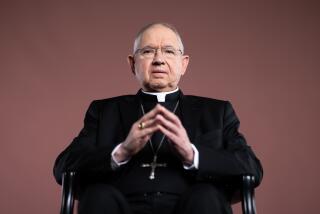Critics Aren’t Sold on Pope’s Commercial Ties
- Share via
MEXICO CITY — The arrival of Pope John Paul II in Mexico on Friday was serenaded by the jingles and heralded by the billboards of 25 official corporate sponsors and other company promotion campaigns--including postage-stamp-sized papal pictures in bags of Sabritas potato chips.
Along the Boulevard of Mysteries, where the 14 Stations of the Cross are spaced over a mile-long sidewalk leading to the Basilica of Our Lady of Guadalupe, posters announced “Mexico: Always Faithful.” At the bottom of the slogan was the Pepsi logo.
“If anyone invented public relations, it was the Catholic Church,” the official Roman Catholic diocese weekly New Criteria said last week in response to a torrent of criticism from the public and the media of the sponsorship program. “The public relations industry merely followed the church, to sell products instead of ideas.”
Mexico City Cardinal Norberto Rivera has stressed that, beyond the church’s need to pay for the visit, the publicity is playing an important role in supporting a primary purpose of the papal trip: to encourage a new evangelization in the Americas at the dawn of the new millennium.
Indeed, in contrast to John Paul’s first papal visit in 1979, when millions poured into the streets to see him personally as he raced around the country celebrating outdoor Masses, this time the aging and frail pontiff has scheduled few large public events and will not be leaving Mexico City.
Rather, the church is depending heavily on the media, especially television broadcasters, to convey the pope’s messages to television viewers in every corner of the country. Television now reaches far more Mexicans than it did two decades ago.
Bishop Luis Morales Reyes, from the northern city of Torreon and president of the Mexican Bishops Conference, said: “This visit will be different in that there will be a deepening of the reception of the message. It will go beyond the festivities and will pierce more deeply into people’s souls.”
The huge media contingent itself contributed to cover some costs.
Press credentials cost $300 each for foreign journalists. Of course, the media also took advantage of the pope’s impending visit to generate publicity. One full-page ad for the Radio Red network shouted, “Juan Pablo and Martin on the Network,” promising that anchorman Martin Espinosa “will turn himself into the shadow of his holiness, and you won’t have to leave him for a moment.”
Columnists and cartoonists were merciless. One cartoon showed the pope wondering, “With so many commercial messages, will I get any time to deliver the divine message?”
In fact, one of the pope’s constant themes since the collapse of communism in the East Bloc has been concern that rampant capitalism is undermining more important values of faith and family.
The Mexican Consumer Defense Assn., protesting the potato chip campaign, said: “On repeated occasions, Pope John Paul II has severely criticized commercialism and its alienating effects. But this message does not seem to have been heard by organizers of the visit.”
In a survey of 202 priests that was conducted by the Mexico City daily Reforma, 64% said they disagreed with the way in which the image of the pope has been commercialized. Just 22% approved.
Cardinal Rivera told Reforma recently that “the church has set a goal of achieving a greater presence in the media, knowing there are risks of making mistakes.”
Guadalupe Loaeza, a prominent social critic, wrote an open letter to the pope saying: “Believe me, holy father, each time I saw [the ads] on the TV screen, I closed my eyes and said with devotion, ‘Forgive them, Lord, for they know not what they do.’ ”
More to Read
Sign up for Essential California
The most important California stories and recommendations in your inbox every morning.
You may occasionally receive promotional content from the Los Angeles Times.













